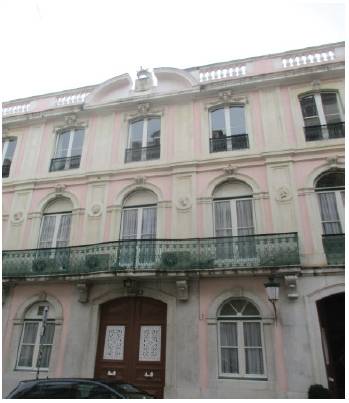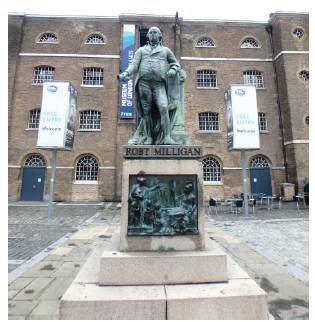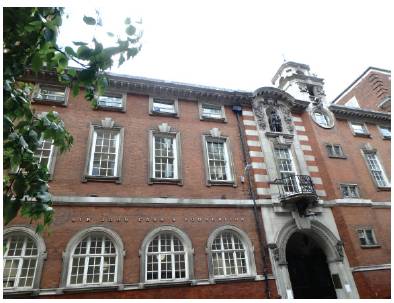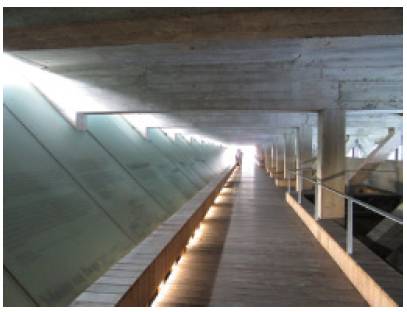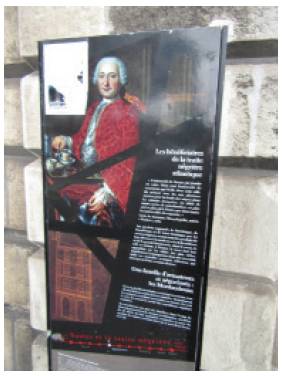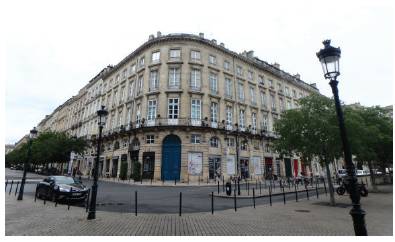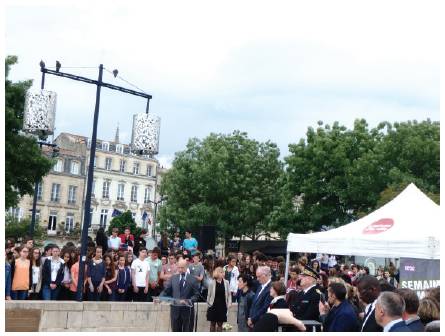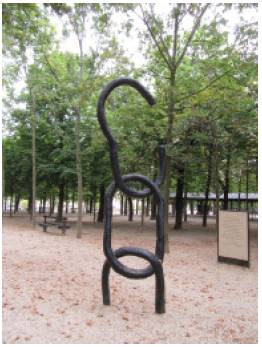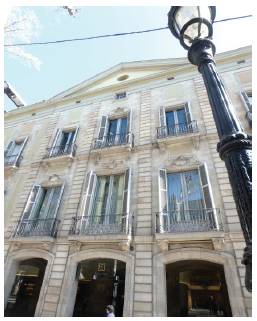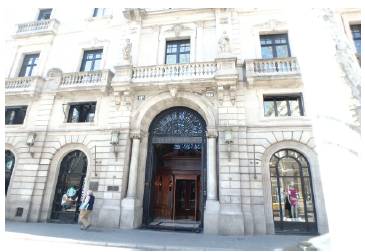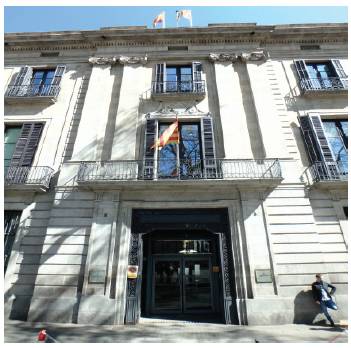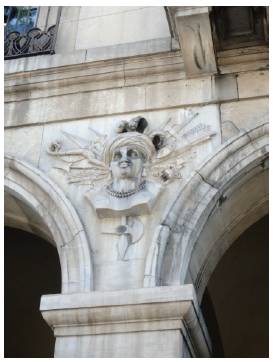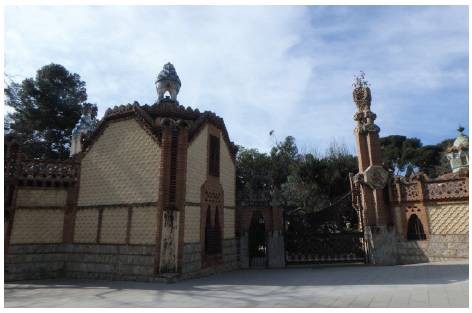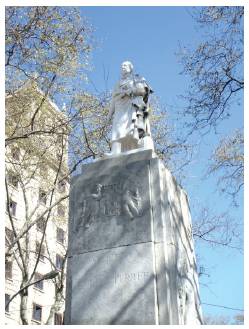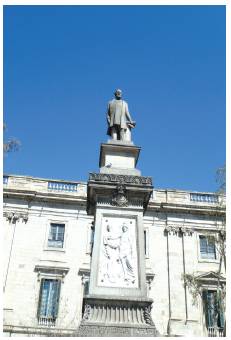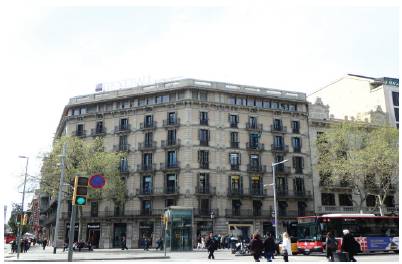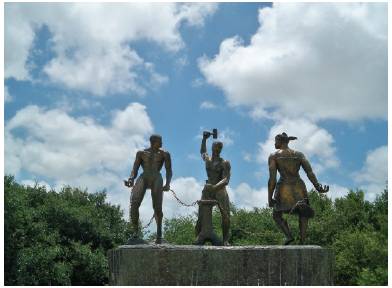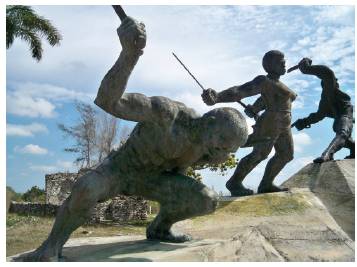Introduction
While I was studying the history of slavery and post-emancipation in Martinique and Cuba (Schmieder, 2013; 2017), I began to ask myself how the societies which profited from Atlantic slavery, and the societies which suffered from it handled this uneasy past, intertwined with guilt and victimization on the one hand, but also the resistance on the other. Who remembered, and who forgot this shared history? Who spoke about its long term consequences, and who silenced them? How did the dominant discourses and countermemories differ? To whom were the monuments built? Was slavery present in historical museums? What happened to the islands with the remains of plantations, master houses and the barracks where the enslaved lived? I decided to dedicate my next project to sites of memory in the regions where I studied the historical slavery -the plantation colonies of Martinique and Cuba, and their former colonial powers France and Spain- for both an academic and a practical reason. The memories of slavery in France and Spain are much less researched than with respect to Britain (Oldfield, 2007; Rice, 2010; Wood, 2000; 2010; Smith, Cubitt, Wilson & Fouseki, 2011). Sometimes the memories are compared with Britain (Chivallon, 2005; Hourcade, 2014) or Brazil (Araujo, 2010), but not with each other. Knowledge about the historical processes during and after slavery is necessary to research the memories and politics on slavery today. My focus is directed not so much at the sites of memory, the contents of museums, the aesthetics of statues and memorial, but on social agency around the sites of memory. Who promotes and who tries to prevent the inclusion of the slave trade and slavery in a historical museum of a town or region, or the establishment of memorials for abolitionists or enslaved rebels and Maroons? Who demands a critical plaque on a monument which tells the public that a certain benefactor of the town could make donations because he became rich through the slave trade or the possession of Caribbean plantations?
Who uses an established site of memory and how? Does a memorial become a “lieux de mémoire” in the sense of Pierre Nora (Nora, 1990, pp. 26-27): a site with symbolic value, social and cultural functions for the commemorating society where a historical phenomenon -here slavery- is evoked regularly with ritualized ceremonies? I think that what a society remembers and what it silences says much about today’s social and ethnic power relations, inclusions and exclusions. In the International Decade for People of African Descent (2015-2024) the question how Atlantic slavery, a founding institution of contemporary racism against Afro-descendant people, is commemorated on both sides of the Atlantic Ocean is a politically and academically relevant issue. I do not present here completed research, but the first results of my short stays in France, Spain and Cuba.
Historical Background: Atlantic Slavery, Capitalism and the Richness of European Port Towns and Capitals of Former Empires
The Atlantic slave trade and plantation slavery were the axes of European empires, which owned colonies in the Americas and forts in Africa as the basis for the slave trading. They were also connected with colonies beyond the Atlantic world, due the necessity to sell Indian cloth and Chinese goods to African rulers, in order to buy enslaved Africans for the Caribbean plantations.
For a long time, the impact that the slave trade and plantation slavery had on European societies -economically and socially- was discussed in academic circles, at least since Eric William’s “Capitalism and Slavery” (1944) and Sydney Mintz’s “Sweetness and Power” (1985), but it was no part of national, regional and local histories. In the last three decades this has changed, but at very different rhythms in the former metropolises. Before I look at the heritage and memory of slavery I would like to explain the historical relationship between the Caribbean and Europe and the development of historical research on that topic.
In “Capitalism and Slavery”, the Trinidadian historian Eric Williams criticised the contemporary British version of history telling that benign white male abolitionists from Britain ended slavery because of their philanthropic ideas against the British economic interests (Coupland, 1933). Williams, instead, insisted that slavery was abolished because it had become unprofitable in the industrial age, after the Atlantic slave trade and slavery had financed a great part of the Industrial Revolution in England (Williams, 1994, pp. 98-107, 126-134, 179-196).
Although both theses were contested (Drescher, 1977; 2002; Thomas & Bean, 1974; O Brien, 1982), his book has produced voluminous historical research and decade long debates (Solow & Engerman, 1987; Hudson, 2014). We know today that Haitian slaves liberated themselves (Fick, 1990; Geggus 2002; Dubois 2014) and their emancipation was based more on African traditions and ideas (Thornton, 2000) than on European enlightenment as the pioneering historian Cyril L. R. James had thought (James, 1938). Many abolitionists were actually black and half of them were women (Cuba: Ferrer 1999, British Caribbean: Ripley, 1985; Walvin, 2000; Maddison-MacFayden, 2013, USA: Quarles, 1969; Yee, 1992; Cameron, 2014). The enslaved fought everywhere in the Americas actively for their own emancipation (Genovese, 1979; Price, 1996; Laviña & Ruiz-Penado, 2006; Thompson, 2006; Heumann; 2011; Ferrer 2014; Barcia, 2014; Schmieder, 2017, pp. 39-42, 139-155, 211-231).
The slave trade did not produce enormous profits as Williams had thought, but neither did it only produce losses as his early adversaries had stated (Thomas & Bean, 1974). It was a risky business, as one could become very rich and one could lose everything. The overall profit rate was 10% (Richardson, 1976; Füllberg-Stolberg, 2010). Plantation slavery stayed profitable until its abolition, particularly during the so called “Second Slavery”, which produced sugar in Cuba, cotton in the US South and coffee in Brazil, took place on large plantations with hundreds of slaves and involved industrial processing of the agricultural products (Tomich 2004, pp. 61-69; Laviña & Zeuske, 2014).
The Industrial Revolution happened not only in British textile factories, but also in Haitian and Jamaican sugar plantations (Burnard & Garrigus 2014), and in Cuban sugar centrals (Tomich, 2004, pp. 79-94, 129-132; Marrero Cruz, 2006). Slavery is nothing external to capitalism, but intertwined with the global capitalist development (Zeuske, 2015, pp. 270-293, 320-364).
Historians of the British Empire argued, against the Williams theses that only a very small percentage of the investments in the British Industrial Revolution came directly from the slave trade inside the British Empire (Anstey, 1974, between 0.11 and 7.9 % according to different assumptions) or from the overall British overseas trade (O´Brien, 1982, 15 %). They ignored the unregistered slave smuggling and the indirect Atlantic trade through Spanish and Portuguese ports. Wallerstein (1989), Inikori (2002), Findlay & Rourke (2007), Maddison (2007), Hudson (2014) and Draper (2014) criticize the minimizing of the importance of the slave trade, the plantation production of cotton and sugar by slaves, and overseas markets in Africa and the Americas for the British Industrial Revolution in order to perpetuate the myth that Europe reached its temporary global superiority by its own efforts, backed by presumed superior bourgeois values, and not by the exploitation of others. They developed a more complex model than that of Williams according to which British manufacturing, American agriculture and the African slave trade were deeply intertwined and the highest share of American export commodities (over 80%) was produced by enslaved Africans specifically during the take-off decades of the Industrial Revolution (Inikori, 2002, p. 197). Solow and Inikori also remarked on the importance of Brazilian and Caribbean markets for manufactured goods (woolen, linen, cotton textiles and products of the metal industry) from Britain and thus were an incentive for industrial development (Solow, 1987, p. 728; Inikori, 2002, pp. 412-472). They point to the connection between trade and violence. Britain used its superior power on sea to gain access to markets and exclude others, which has nothing to do with free trade and fair competiveness. Sven Beckert even speaks of “war capitalism” where “inside” Europe laws and institutions ruled economy and society, while “outside” “imperial domination, the expropriation of vast territories, decimation of indigenous peoples, theft of their resources, enslavement, and the domination of vast tracts of land by private capitalists with little effective oversight by distant states” characterised the capitalist development (Beckert, 2015, p. 38). Hudson underlined the continuity of British involvement in Atlantic slavery after 1807 -the prohibition of the slave trade- and 1833 -the abolition of slavery in the British Caribbean-, and the profit transfer to the industrial development of the 19th century (Hudson, 2014, pp. 48-51). Draper has shown that the “slave compensation” paid to former slave owners after 1833 was invested in other trades in Britain and overseas, in British cotton-manufacturing, railways and shipping, banking and insurance (Draper, 2014).
French historians showed that the 18th century slave merchants bought land with profits from that trade because they wanted to become landlords with nobility titles, not factory owners. Many of them became bankrupt after the Seven Years War or the loss of St. Domingue as they also owned Haitian plantations (Thésée, 1972; Butel, 1974; Pétré-Grénouilleau, 1996). A new generation of merchants participated in the illegal slave trade of the 19th century, particularly with Cuba, and also invested the profits in local industries (Boulle, 1975; Daget, 1975). In Portugal, the crown, state and the church of the Ancien Régime profited from the slave trade by Henry the Navigator in the 15th century (who owned the slave trade monopoly with Africa and is honoured today with memorials in Porto, Lisbon, Tomar, Sagres, Lagos and other Portuguese towns) throughout the slave trading assets in the hands of king José I, and his minister Marquess of Pombal (who is a hero of the Portuguese enlightenment, to whom a big monument in Lisbon is dedicated), till the noblemen of the Court and catholic convents trading enslaved Africans in the 18th century (Magalhães Godinho 1962, pp. 188-208, Caldeira 2013, pp. 219-224). 19th century slave merchants of more humble origins bought nobility titles and invested the slave trade profits in the banking system, the port towns, and Portuguese welfare and educational institutions (Caldeira, 2013, pp. 262- 269, 274-278). The Industrial Revolution did not only take place in England.
Spanish historians have shown that the late industrialization of Spain was financed partially by the profits by the illegal slave trade to Cuba and the sugar plantations on the island (Bahamonde & Cayuela, 1992; Rodrigo 2007, 2012).
The so-called indianos went poor to the Americas and when they came back, enriched through the slave trade and plantation slavery, they transferred the profits made in Cuba and Puerto Rico not only to Spain, but also to Great Britain, France and the United States. They were global players (Bahamonde & Cayuela, 1992; Rodrigo 2013b, 2015). There is no study that paints a general picture to what degree the capital of the illegal slave trade and “Second Slavery” was invested in the capital of world economy of the 19th century, London, and Great Britain in general. We have many good studieson ships, ports/port towns and merchants in the slave trade (France: Butel, 1974; Harms, 2001; Guillet, 2010; Michon; 2011; Saugera, 2012; Spain: Rodrigo, 2013b, Portugal: Caldeira, 2013, Great Britain: Richardson, 1976; Schwarz 1996 (2008); Dresser 2001; Morgan, 2007). However, global capitalflows around the slave trade and the plantation systems seem to be so complexthat a study would not be able quantify them conclusively. To find out theactual sum of capital invested in European industrial development in the late18th and 19th century it would be necessary to form a group of internationalresearchers like the one which created the Transatlantic Slave-Trade Database(Eltis & Richardson, 2008).
At least, one should follow Barbara Solow: “Slavery did not cause the Industrial Revolution, but played an active role in its pattern and timing” (Solow, 1987, p. 732), and Angus Maddison “Most of the European trading nations profited from the enslavement of Africans” (Maddison, 2007, p. 312). What we know for sure is:
Transatlantic slave trade pushed the development of European banking and insurance forward (Williams, 1994, pp. 98-102, 104-105; Rodrigo, 1998; Inikori, 2002, pp. 314-361; Castañeda & Rodrigo, 2004; Roldán, 2015).
Transatlantic slavery promoted the shipping industry, including the acquisition of nautical and geographic knowledge (Williams, 1994, pp. 57-60;
Inikori, 2002, pp. 265-313; Maddison, 2007, pp. 311-313).
African, Caribbean, North American and Brazilian markets for linen and cotton textiles, weapons, tools, ironware and agricultural products promoted proto-industrial and industrial development and jobs in European coastal and hinterland regions (Williams, 1994 pp. 64-73, 81-84, 105-107; Butel, 1967; Kellenbenz, 1971; Richardson, 1987; Reikat, 1997, pp. 118-122, 143-162, 178-180, 198-202; Inikori, 2002, pp. 405-473; Zeuske, 2004a; Findlay & Rourke, 2007, pp. 339-345; Morgan, 2007; Weber, 2015; Steffen &Weber, 2016; Overkamp, 2016).
The illegal slave trade and the “Second Slavery” promoted the 19th century industrial development in Britain and France, but also in latecomer industrial countries like Spain, particularly in Catalonia (Bahamonde & Cayuela, 1992; pp. 53-85, 141-181; Solà, 2012; Hudson, 2014; Rodrigo, 2015; Zeuske, 2015, pp. 286-287).
One must cross imperial borders to understand the whole phenomenon of Atlantic slavery, as in the 18th and 19th century British industry benefitted not only from slavery in the British colonies and later the United States, but also from the output of the slavery based plantations in Cuba and Brazil and sales of manufactured goods to slaveholding societies, as in Brazil and the Spanish Caribbean (Stein & Stein, 1970, pp. 86-96, 147-150; Bahamonde & Cayuela, 1992, pp. 53-139; Inikori, 2002, pp. 473-486; Solow, 1987, pp. 728-737).
The importation of sugar, coffee, cacao and cotton created new industries and jobs in Europe (Williams, 1994, pp. 73-81; Zeuske & Ludwig, 1995; Morgan, 1998; Villeret 2015).
The importation of sugar, coffee and tea changed the consumer habits and everyday life of Europeans (British teatime, French or German cafés as places of political debates, and German women´s “Kaffeekränzchen”, afternoon coffee circles). Coffee and tea were beverages compatible with factory work, due to the necessity of workers being very attentive, in contrast to the former practice of beer drinking during the day and work time (Mintz, 1985; pp. 74-150, 180-186; Zeuske & Ludwig, 1995).
The most important new industry of cotton textile production in European hinterlands could only expand as fast as it did because of the cheap supply of raw material produced by North American slave labour (Williams, 1994, p. 162; Findlay & Rourke, 2007, p. 341; Inikori, 2002, p. 377; Beckert, 2015, pp. 98-122).
In contrary to controversial theses on slavery and industrialization, no one doubts that slave traders invested their money in sumptuous private houses, cultural and charitable institutions in capitals and port-towns of the Atlantic slave trade, like in Liverpool, the biggest slave trade port town in Britain, in London, number two, in Bristol, number three (about the ranking: Morgan 2007, p. 21; about the slave trade and the towns: Anstey & Hair, 1976; Richardson, 1986; Morgan, 1993; Rawley, 2003, Richardson, Tibbles & Schwarz 2007). For instance, in Liverpool the Blue Coat Hospital for the Indigent Poor, founded in 1708, was financed and managed by Bryan Blundell and Reverend Robert Stythe partially with slave trade profits; the Liverpool Town Hall, formerly Liverpool Exchange, was built by the construction firm of slave merchant Joseph Brooks and the Building of the Royal Institution, the forerunner of Liverpool University, was built in 1799 as a residence for the slave trader Thomas Parr (Westgaph, 2009). The slave merchant Sir Robert Clayton (member of the Court of Assistants of the Royal African Company, 1672-1682), was a benefactor of the Old St. Thomas’s Hospital in Southwark, London (Dresser 2007, pp. 171-172). The slave trader, director and investor of the Royal African Company, Sir John Cass, founded schools in London. His name -honoring, not criticizing him- survives in the Sir John Cass Foundation which finances schools and University faculties -The Sir John Cass Faculty of Art, Architecture, and Design at the London Metropolitan University, the Sir John Cass School of Education at the University of East London, and the Cass Business School at City University- (Dresser, 2007, p. 166; Donington, 2016, p. 181)2. The Manor House Library in Lee, London, “was home to several generations of London merchants involved in slave trading”3. The famous Queens Square in Bristol was a slave trader quarter, with residences of the slave merchants Abraham Elton II, James Laroche (the most important slave merchant of the period: 132 slaving voyages between 1728 and 1769), homas Freke, John Anderson, Woodes Rogers, Isaac Hobhouse, Joseph Jefferis, and Henry Bright (Dresser, 2001, p. 106). The Theatre Royal, which also opened in Bristol in 1766, was financed by various slave merchants (Dresser, 2001, p. 108, 124).
The oldest and most important slave trading nation was Portugal (46.7% of enslaved Africans were transported on Portuguese ships to the America, Eltis & Richardson 2008, pp. 40-41). The profits of the slave trade here also went to urban development, for instance to Lisbon, Porto and Lagos. The cultural institution Grémio literário in Lisbon has had its seat since 1875 in the former residence palace of the slave merchant Ângelo Francisco Carneiro, Viscount of Loures (Image 1, Biase Albuquerque, 2015)4. The Hospital of Porto was financed by the slave trader Joaquim Ferreira dos Santos, Count of Ferreira (Caldeira, 2013, p. 278).
Slave Trade, Slavery and Urban Memory in Europe The European Context: Great Britain, Portugal and Minor Slave Trading Nations Great Britain has seen itself as an abolitionist nation, or to borrow the words of Eric Williams: “The British historians wrote almost as if Britain had introduced slavery solely for the satisfaction to abolish it” (Williams, 1966, p. 233). The bicentenary of the prohibition of the Atlantic slave trade by Great Britain (2007) brought a (slow) change, particularly because minorities from the Caribbean and Africa, flanked by critical historians and intellectuals, contested the abolitionist hagiography in the United Kingdom (Walvin, 2011; Tibbles, 2008). Exhibitions and museums all over the United Kingdom presented the slave trade past in 2007 (Prior, 2007; Rice, 2010, pp. 55-80). In Liverpool the International Slavery Museum was established. This museum shows the slave trade past of the most important port town of the Atlantic slave trade, but also tries to explain the whole story of slavery in the Atlantic space, with a strong focus on the British Atlantic world, but also with African cultures and the legacies of slavery (International Slavery Museum, 2010). In London, an exhibition in the Museum of London Docklands on “London, sugar & slavery”, presents the following topics: the involvement of London slave traders and slave owners in the transatlantic slave trade and plantation slavery, the importance of the slavery based Atlantic economy for the town and the Empire, the organization of slave labour and the resistance of the enslaved in the Caribbean, the history of blacks and black abolitionists in London, the change of consumer habits through colonial agricultural products, the systems of forced labour in the British Caribbean colonies after abolition and the legacies of Atlantic slavery, for instance in racist discrimination (Museum of London, 2016, pp. 22-29)5. Also the National Maritime Museum in Greenwich dedicates the Atlantic Gallery to the topic of the slave trade and slavery with a stronger focus on conflicts between European powers over plantation colonies, war history and the Haitian slave revolution (Hamilton, 2007; National Maritime Museum, 2011)6. In Bristol parts of the exhibition “A Respectable Trade? Bristol and Transatlantic Slavery” in the Bristol City Museum and Art Gallery of 1999 became part of the Bristol Industrial Museum, and, after its closure, part of MShed, the new Museum of Bristol (“Slave Trade Gallery”) (Otele, 2012)7.
Monuments to the victims of the slave trade and slavery were also built. The “Pero Bridge” in Bristol was opened in 1999, and named after Pero Jones, “an African slave who had been purchased in Nevis in the West Indies by the plantation owner John Pinney, ... . Pinney brought Pero back with him when he moved to England in 1783”8 (see also: Dresser, 2001, p. 81). In Lancaster in 2005 the monument “Captured Africans” by Kevin Dalton-Johnson was erected as part of the Slave Trade Arts Memorial Act (STAMP) (Rice, 2010, pp. 48-51, fig. 9). Lancaster had been the fourth slave trade port of Britain and its hinterland, Lancashire, a center of textile production for Atlantic (African, Caribbean and North American) markets (Hudson, 2014, p. 43). The Gilt of Cain Monument in London, by sculptor Michael Visocchi and poet Lemn Sissay, 2007, was unveiled by the Archbishop Emeritus Desmond Mpilo Tutu on 4th September 2008, in the context of the bicentenary of British prohibition of the slave trade, in Fen Court, a place historically connected with the slave trade and its abolition (Rice, 2010, pp. 17-23, fig. 3)9. Fen Court is green oasis between very high modern buildings, with a very small path from Fenchurch Street to the court, difficult to find. I do not share Rice’s optimistic view of the memorial. What sense does a monument have, as artistically impressive it may be, which is hidden from the local public and tourists and will be only found by someone looking for it?
The discussion about slavery legacies leads to the question what towns should do with slave merchants who were honoured as benefactors of cities, for instance with statues, street and institution names. Their ugly business is normally not mentioned there. This refers, for instance, to the statue of slave merchant Edward Colston in Bristol (1636-1721), member of the Court of Assistants in the Royal African Company, “investor in a local sugarrefinery and in Antigua”, and at the same time “great patron of many Bristol churches and charities” (Dresser, 2009, p. 224). Besides his involvement in the slave trade, slavery and controversial debates around it, there is no comment on the monument referring to this past. In London, the statue of the slave trader Robert Milligan is situated in the London Docklands (Image 2, Dresser 2007, p. 179) and the statues of the slave merchants Sir John Moore (member of the Court of Assistants of the Royal African Company, at the end of the and the beginning of the 18th century), Sir Robert Clayton (above mentioned), Sir John Cass (above mentioned, Image 3), and William Beckford, inheritor of 13 sugar plantations and around 3 000 slaves in Jamaica in the 18th century (Dresser, 2007, p. 166), can be found in different places in London, without any comment on slavery.
The whole of Lisbon, from the quays to the river, from which the ships started; the central place; the Terreiro do Paço with the old Customs House (today the Ministry of Finance), in which the old house of slaves was included and the Terreiro (Largo) do Pelourinho Velho, formerly the slave market, has a connection with the historical slave trade and current Portuguese African culture (Castro & Pereira Leite, 2013). Until very recent times, this was neglected completely. But now, in 2017 the museums in Lisbon presented their objects referring to slavery in exhibitions in 42 places10. In the small port town of Lagos a museum of the slave route was opened in the former Slave Market in 2016 11. The Dutch slave trade to the Dutch Caribbean colonies and Suriname is presented at the National Slavery Monument in Amsterdam and was displayed in an exhibition in the Maritime Museum in Amsterdam in 201412. The German port town Flensburg, formerly belonging to Denmark, has recently opened an exhibition “Rum, Sweat, and Tears”13 in its Maritime Museum showing the town’s entanglements with the slave trade and Atlantic slavery, whereas a general exhibition on German colonialism in the German Historical Museum (Deutsches Historisches Museum, 2016) was very brief on German participation in the Atlantic slave trade. A Museum on Slavery has, as of yet, only been established in Liverpool and Lagos.
Sites of Memory and Silence: France and Spain Compared
With reference to France I will be looking at the slave port towns of Nantes and Bordeaux, as well as the colonial capital Paris. The festivities around the 150th anniversary of the abolition of slavery in the French colonies (1998) brought up a broad discussion in France about the issue of remembrance of slavery and abolition. Afro-Caribbean groups contested the official history of the “Grande Nation des droits de l´homme” which generously abolished slavery because of its enlightened tradition (Cottias, 1997; Schmidt, 2012), with a silent march on May 23 (in Martinique slavery was abolished after the insurrection of the enslaved the day before, Pago, 2006). They declared that the memory of the descendants of slave owners and the descendants of the enslaved could not be the same, and that one should not only remember abolition, but also and above all the historical guilt of France as an enslaving nation, and the fight against racism as a legacy of slavery. In 2001 the French parliament recognized the slave trade and slavery as crime against humanity, with the Law Taubira, an initiative of the Afro-Guyanese deputy Christiane Taubira. Whereas this law demanded a critical reflection of slavery in school curricula, article 4 of the Law Repatriés of 2005 ordered a positive evaluation of French colonialism in schools and Universities. In 2006 the article was cancelled after a wave of protests and May 10 (day of the promulgation of the law Taubira) became the Day of Remembrance of Slave Trade, Slavery and its Abolitions (Araujo, 2010, pp. 77-79; Michel, 2015, pp. 145-243). Although there are deep-routed conflicts over the memory laws and the question how to remember the colonial past and slavery, many expositions, political and cultural events have evoked that memory. The first slave trade port town of Nantes (Daget, 1975; Pétré-Grénouilleau, 1998; Bodinier & Breteau, 1994) has been the precursor of the official commemoration of its slave trade past ever since the big exhibition of 1992-1994, “Nantes-Europe - Afrique - Amériques”, was organized by the organization Anneaux de la Mémoire. Nantes is now the place with the most sites of commemoration in France. Hourcade explains the advanced role of Nantes with the cooperation of a coalition of engaged historians, the team around socialist Mayor Jean-Marc Ayrault and black activists with moderate political demands (Hourcade, 2012, p. 128).
The Musée d´Histoire has included three rooms which reflect the role of Nantes and its hinterland in the Atlantic slave trade and the exports to the Caribbean since 200714. They also give a general overview of the Atlantic slave trade, plantation economy, slavery and include documentary films and different media. For instance, a voyage of a slave ship is described from the perspective of a young French seaman. Sources which mirror the perspectives of the slaves are unfortunately missing. Most critique points to that fault (Hourcade, 2012, pp. 128-129). Whereas the historical museum concentrates on the interrelation of the town and the slave trade, the open air Mémorial de l´abolition de l´esclavage in Nantes, which opened in 2012, is dedicated to the international fight for the abolition of slavery (Image 4, Vergès, 2015).
Only the glass plaques set into ground on the way to memorial remember slave ships which started from Nantes. The stone construction below the earth is intended to evoke images of a slave ship. Quotations from the speeches of historical personalities (enslaved narrators, abolitionists, contemporary politicians and artists) and from texts of French laws refer to the value of freedom.
The voices of the enslaved and women are underrepresented (4 and 5 of 37 quotations, respectively, Frith, 2015, p. 84). Regrettably, the planned education centre was not built because of financial reasons. The informative value of the monument is thus very low and consists of a map and a timeline of abolitions.
When I spoke with historian of the Anneaux de la Mémoire, Jean Breteau, in May 2016, he was very critical about the whole monument, which is nearer to the French tradition of the self-styling of the Nation which invented human rights, and less of a critical remembrance of the past. A memorial to abolition makes little sense in a town whose leading families opposed the abolition of the slave trade. Behind the critique there is also perhaps a conflict between the organizations Anneaux de la Mémoire and Mémoire d´Outre-Mer, the latter led by Martinican Octave Cestor, the principal promoter of the Memorial (Hourcade, 2014, pp. 216-222). The small groups of African activists in Nantes like Jean-Paul Ngassa and Peter Lema from the Passarelle Noire express strong criticisms against this form of memory, as it also has the aim to promote a positive image of the town in light of its history. They think that this versión excludes the African perspective (Hourcade, 2014, pp. 223-227). My personal critique is that the quotations say little without explanations of historical context and the quoted persons themselves. The absence of the voices of the enslaved can be explained by the fact that French (Caribbean) historians only recently published sources which reflect the position of the enslaved (e.g. petitions and courts records with respect to mistreatment) (Oudin-Bastide, 2008, 2015; Rogers, 2015; Régent, Gonfier & Maillard, 2015). The critique on the absence of African or Afro-Caribbean voices cannot be applied to the itinerary exposition titled “TOSTEM, Tourism around sites of the slave trade, slavery and their memories” created by the Anneaux de la Mémoire with historians, activists and artists from Cameroon, Senegal, Antigua, Barbados and Haiti. The organization Anneaux de la Mémoire, in an exhibition in Angers, also presented the entanglements of the hinterland of Nantes and the región Loire-Atlantique with the Atlantic world and the slave trade, and in doing so approached a little known theme15. Not only European capitals and port towns profited from Atlantic slavery, but the hinterlands, too (Brahm & Rosehoft, 2016).
As in Great Britain slave merchants built impressive houses in Nantes. For instance an association of slave merchant shareholders built houses on the Quai de la Fosse (the slave trading family Montauduin), and the Île Feydeau.
These luxurious houses were often adorned with masks, called “mascarons”, which sometimes carried African features, evoking memories of the Atlantic slave trade. A slave trade trail makes that past visible in the public space with coloured plaques (Image 5)16.
In contrast to Bordeaux (French slave trade port number two (Saugera, 2002), the buildings built with slave trade profits like the Hôtels Nairac (Paul Nairac holds the record for 84 armed slave trade expeditions from Bordeaux between 1740 and 1792), Fonfrède, Journu (Image 6), Couturier, Gradis and Camescasse are not marked as such.
Many buildings in the whole town (for instance the former bourse, also adorned with masks representing Africans) and its surroundings have historical connections with the slave trade (Pétrissans-Cavailles, 2004, pp. 43-60, about Nairac, p. 52). The town started to remember this dark side of its wealth only under the pressure of the Taubira Law. The fight of activists, mostly African students, since the 1980s had not brought success until then. The fact that a small commemorative plaque near the Quays is barely able to be found was strongly criticized by the pro-remembrance-organization DiversCités (Hourcade, 2012, pp. 129-133). The plaque becomes a site of memory in the sense of Nora through the ceremonies on May 10, Day of Remembrance of Slave Trade, Slavery and its Abolitions (Image 7).
After long debates the Musée d´Aquitaine in Bordeaux has dedicated, since 2009, three rooms to the involvement of Bordeaux in the slave trade and the ownership of plantations in St. Domingue by merchants of Bordeaux17.
The voices of the enslaved are more present here than in Nantes through the sources projected by visual media. The museums also display the content of its exposition outside in the public space. As the museum is situated in a historical building and not in a castle less tourists will be attracted to it than to the castle-museum in Nantes, but school classes will learn much in the well documented rooms.
The metropolises have to recognize that they were capitals of Empires which exploited slave labour and benefitted from the slave trade. The Parisian memorial “Le Cri, l´Écrit”, by Fabrice Hyber of 2007, in the Jardin de Luxembourg (Image 8, Rice, 2010, p. 27) is an abstract monument of broken chains. While it honors abolition and incorporates the enslaved into the nation that founded the concept of human rights, it does not approach the issue of guilt. This impression becomes even stronger if one reads the plaque: “For their struggles and their deep desire of dignity and freedom. The slaves of the French colonies have contributed to the universality of human rights and the ideal of liberty, equality, and fraternity which found our Republic. France here pays homage to them” (my translation).
“Le Cri, l´Écrit”, “Gilt of Cain” and the plaque in Bordeaux are pretending to remember places, too small and too hidden to be found by casual bypassers.
The monument “Fers” in the Place Cartroux, dedicated to the family Dumas, honors General Thomas Alexandre Dumas, the father of the famous writer and a former enslaved person from St. Domingue, who bought his freedom, advanced as first Afro-Antillean man in the French Revolutionary Army and was forced to retire without a pension by Napoleon Bonaparte in 1802. The memorial, created by Musée Khômbol and unveiled in 2009, consists of two big broken chains, and combines the commemoration of the French Revolution and the first abolition of 1794, recognizing at least the role of self-liberation by the enslaved (Dorigny & Zins, 2009, pp. 255-257). There is no museum dedicated to slavery or to colonialism in the French capital.
The Pantheon has honoured a long time only white French abolitionists Abbé Grégoire, Marquis de Condorcet and Victor Schoelcher. The only persons of African descent venerated here had been the writer Alexandre Dumas and Félix Eboué, the Guyanese Governor of Chad, hero of the resistance in World War II until plaques for black anti-slavery leaders Toussaint L´Ouverture and Louis Delgrès as well as Martinican anti-colonialist writer and politician Aimé Césaire were added18.
With respect to Spain19, I look at Cádiz, Barcelona and the capital Madrid: Cádiz had the monopoly of trade to Spanish America in the 18th century (1717- 1778) (García Baquero, 1976). The Compañía Gaditana de Negros owned from 1765 to 1779 the asiento, the monopoly to sell slaves to Spanish America (Torres, 1973). The fact that Cádiz also played an important role in the ilegal trade in enslaved Africans to Spanish America, particularly in Cuba (Sosa Rodríguez, 1997) and Brazil is not even researched with reference to basic data about numbers, ships, traders and profits20. In Cádiz no monument and no museum remembers the slave trade past of the town and the Museum of the Cortes of Cádiz (of 1812) does not touch the topic, although two petitions of the abolition of slave trade were made to this parliament and rejected. A large monument built in 1922 honours Claudio López Bru (Faes Díaz 2009), Marquess of Comillas II, a catholic politician, benefactor and business man, whose properties had their origin in the slave trade of his father Antonio López y López, Marquess of Comillas (Bahamonde & Cayuela, 1992, pp. 56-59, 141-143, 150-155, 161-166, 217), what is not mentioned at the monument.
Barcelona was the centre of the illegal Spanish slave trade of the 19th century (Fradera 1984, Rodrigo, 2013 a, Rodrigo/ Chaviano, 2017) and the town where most indianos bought their real estate and invested their capital in local industries (Rodrigo, 2012; Solà, 2012)21. Barcelona is an example of a city with a mostly hidden slave trade past. It is hidden by politics, although academic studies, for instance by Martín Rodrigo Alharilla, exist showing the involvement of leading families of the town in the slave trade and the transfer of capital from the slave trade and the Cuban plantation economy based on slave labour to the banking system, textile and other industries, steam ship lines and railroads of Catalonia and the urban development of Barcelona. The long public silence on the role of Barcelona in the Atlantic slave trade was broken by novels and films rather than by local politics, for instance by the TV series “Havanera 1820” by Antoni Verdaguer (1993), the novels by Juan Goytisolo, amongst them “Juan sin tierra” (1975), and Rafael Escolà, “Dinero Negro” (2010) (Surwillo, 2014, pp. 168-191), the latter trivializing plantation slavery in Cuba. A 1995 exhibition “Catalonia and Overseas” in the Maritime Museum documented the involvement of the town in the slave trade and plantation economy (Fradera, 1996), but it did not become part of the permanent exhibition. In 2018 a new exhibition, explicitly on Barcelona and the slave trade, is planned22.
A recent step to overcome the silence is done with a tourist walk remembering the role of the town in the slave trade23, but this walk is not to be found on the official website of the town and the tourist office, and one has to search explicitly for it. Another walk remembering indianos, was developed as “author´s tour” by historians Aymara Arreaza and Lorena Bau (Ajuntament, 2016) with help of Martín Rodrigo. The route touches upon the topic of the slave trade and mentions it in the corresponding flyer, but it does not focus on it. The notion indiano does not include any critic on those involved. Many small towns and villages have developed rutas del indiano, where the slave traders are presented as benefactors as they financed the urban development and charitable institutions (Cabré & Olivé 2011)24.
In March 2017, Javier Laviña and Omar Guzmán, colleagues of the University of Barcelona, showed me places in Barcelona which were historically connected with the slave trade and slavery economy: The Palace Moja (Image 9) was bought in 1870 by the famous slave trader and owner of sugar and coffee plantations in Santiago de Cuba, Antonio López y López, as his prívate residence (Rodrigo, 2012, p. 86, Cabré, 2012, p. 107). The Hotel 1898 (Image 10), another residence of his, was seat of the Transatlantic Company owned by Antonio López y López, who made hugh profits transporting soldiers in the War against Cubans 1895-1898 with his ships. Later it served as seat of the Company of Tobacco of the Philippines, another colonial enterprise (Rodrigo 2012, p. 83, Cabré, 2012, p. 107). Near the Rambla you also find the house of Joan Güell i Ferrer, President of the Anti-Abolitionist League and the Círculo Hispano-Ultramarino of Barcelona who furiously defended Spanish rule in Cuba, colonial protectionism, and invested the capital of his Cuban businesses connected with the slave economy in the textile factory Vapor Vell and the metallurgic factory La Maquinista Terrestre y Marítima (Solà, 2012, p. 75; Schmidt-Nowara, 1999, pp. 61-71).
The house of the son and inheritor of Joan Güell, Eusebi Güell, who was married to the daughter of Antonio López y López, is located near the house of his father (Shubert, 1991, p. 155; Bahamonde & Cayuela, 1992, pp. 153, 163). The latter financed the modernist architecture of Antonio Gaudí with the dirty money of his father and stepfather, but stays a cultural hero in the town´s memory.
The Palau Marc, was built by Tomás Ribalta, sugar oligarch of Sagua La Grande, Central Cuba, Palau Marc (Image 11, Cabré, 2012, p. 108), and the Banco Hispano Cubano was a negrero/esclavista project only (Rodrigo, 1998; Cabré, 2012, p. 109)25. At the Paseo Isabel II one finds the palaces of José Xifré y Casas (Image 12), who was a merchant of slaves, leather, sugar and coffee to and from Cuba, and who later became a banker in the United States (Rodrigo 2012, 2015; Grandas, 2012; Ajuntament, 2016), and the palace of the brothers Vidal Quadras, the merchants and owners of a coffee plantation in Santiago de Cuba and founders of the bank Vidal Quadras Hermanos (Castañeda & Rodrigo, 2004; Ajuntament, 2016). Neither here, nor at the Finca Güell (Image 13), inherited by Eusebi Güell and recreated by Antonio Gaudí (Cabré 2012, p. 113), can any comment be found which explains how these people became rich.
Although the name of one avenue at Barcelona was changed from Marquess of Comillas to the anarchist politician Francesc Ferrer i Guàrdia (Surwillo, 2014, p. 165), many streets and places continue to be named after slave traders and indianos and their immediate descendants, who acted as benefactors of the town or promoters of art with money inherited by their indiano parents. I refer to places and streets named after José Xifré y Casas, Antonio López y López, José Agustín Goytisolo, Joan Güell i Ferrer, Eusebi Güell, amongst others. The copies of the statues of the already mentioned colonialist merchant Joan Güell i Ferrer (Image 14) and slave trader Antonio López y López (Image 15) re-erected by the Franco Regime after the demolition by the Republic in 1936 stayed in their place, the latter against a petition of the labour unions CCOO (Confederación Sindical de Comisiones Oberas) and UGT (Unión General de Trabajadores) in 2010 to remove it (Surwillo, 2014, p. 166). In May 2017, the removal of the statue has been announced by the municipal Government26.
Currently, nobody has tried to combine the results of the studies of Martín Rodrigo y Alharilla on the financing of the famous Eixample of Barcelona, the quarter created in the last decades of the 19th century, with many houses planned by Antonio Gaudí and other modernist architects by fortunes obtained by the slave trade and Caribbean plantations (Rodrigo, 2007, p. 284) with the actual street numbering and existing buildings.
Thus, these buildings have not yet been identified, which would be a prerequisite to putting commemorative plaques on them. An exception is the Casa de Goytisolo, which is without a doubt the former residence of slave and plantation owner Agustín Goytisolo in Cienfuegos (Rodrigo, 2016, p. 366, Image 16)27.
The Historical Museum of Barcelona refers only to ancient and medieval times. The Maritime Museum showed in March 2017 a total chaotic exhibition of everything which has to do with shipping. It gives in one vitrine the following false information completely out of every context: “Did you know? 1807, Great Britain, did not only banned slavery. It also began persecuting all vessels involved in this trade. In the votive offering Spanish slave traders give thanks to managing to evade the British navy”28. The Museum of the History of Catalonia, technically impressive, tells a very nationalist story. To paraphrase: the poor Catalans were always persecuted by Castilians, and later by Spain, and they always defended heroically against the oppression. They developed an advanced economy only by their own industrious forces. They are a nation of revolutionary farmers and workers who also were backbone of the Republic of 1931 and the Anti-Franco resistance. Partially that discourse reflects proven historical facts (and painting present Spain as repressive state is more topical as I thought when I visited it), but it leaves out the fact that the wealth of Barcelona was acquired also through the slave trade, plantation slavery, and privileged colonial markets. This does not fit in the above repeated self-description and that is why it is explicitly negated:
Catalan industry came into being on the basis of finance provided by a wide range of sources. Some capital was provided by owners who combined a new business with an existing industry. Capital repatriated from America was also significant. However, most of the steam-powered factories were set up using modest amounts invested by families. Reinvestment of the profits enabled companies to grow in size, leading to the emergence of powerful industrial bourgeois families, who were responsible for the development of a new kind of culture, leisure and social relations29.
The only information about the slave trade is given by a map showing the Atlantic triangle trade. The corresponding text only mentions the trade of salted meat from Buenos Aires to feed the enslaved in Cuba and refers to the legal trade of 30 000 enslaved Africans to Spanish America on ships starting between 1789 and 1819 from Catalan ports. It does not mention the much more important illegal trade in the following decades. Under the text and map you can open compartments where you find sugar, coffee textiles and chains as symbols of enslaved people as commodities. Although the studies of Christopher Schmidt-Nowara revealed that the abolitionist movement in Spain was socially much broader as previously thought and deeply connected with the movement for liberal reforms (Schmidt-Nowara, 1999), the section of the Museum which presents the new thinking of the 19th century does not mention abolitionism.
The silence on the topic does not reflect only the wish to be a pure nation in the context of the fight for Catalan Independence. The Catalan elite fears that a slave trader can be found in the family history. The great-great-grandfather of the President of the Catalan Generality between 2010 and 2016, Artur Mas i Gavarró, Joan Mas Roig, and his brother Pere Mas Roig were ship captains of slave trade vessels (Rodrigo & Chaviano, 2017, pp. 7-10). Pere Mas Roig (“El Pigat”) was one of the most important Catalan slave traders, but his home town Vilassar de Mar honors him as great personality, a strong man and adventurer (Cabré & Olivé, 2011, p. 64). The ancestors of the former vice-president of the European Parliament, Alejo Vidal-Quadras Roca (Partido Popular Catalán) were bankers whose capital was acquired through their activities as merchants and owners of slaves and coffee plantations in Santiago de Cuba (Rodrigo & Chaviano, 2017, p. 10). In times of catalanophobia one should mention that members of the elite all over Spain have slave owners among their ancestors, p. e. Ana and Loyola de Palacio del Valle Lersundi, high-ranking officials in Spanish Governments and international institutions, stem from the family Del Valle, part of the sugar oligarchy of Central Cuba (Rodrigo & Chaviano, 2017, pp. 10-11).
And what about Madrid, the capital of the Spanish Empire? The city maintains the famous Museo de América which does not glorify the conquest in the same way as it did before its reformation in 1994, but the museum´s narrative does not doubt the right of Spain to conquer another continent, or mention the demographic catastrophe of the native population. According to the narrative, all what happened was a nice “meeting of cultures”. Afro- Hispanic Americans appear only in the casta painting, which repeats its racist content with the words “Of Spaniard and black woman: mulatto”, and shows the black wife beating her husband like a fury. The interracial marriage destroys the social order. Only the paintings “Mistress with her black slave” and “Los mulattoes of Esmeraldas” refer to slavery30.
The English flyer which I collected in 2011 said: “The settlement of the Spaniards in America led to the arrival of Africans and Asians, who found their place in the new society carrying out very different roles.” The text does not say that the role of Africans was that of an enslaved people working on sugar, coffee and cacao plantations and in mines under conditions which did not allow for their physical reproduction.
Theoretically a resolution of the Cortes of 2014 by the initiative of the Partido Popular and promoted by the organization Afrohispanos promises “to establish in Spain, when it is considered appropriate, a monument to remember the victims”31. But all Spanish colleagues with whom I talked32 to were sure that those plans will not be realised in the near future as none of the Spanish parties, the left party Podemos included, really pushes this plan forward.
When looking for the reasons of the different stages and forms of commemoration of the slave trade and slavery in the mentioned port towns and capitals, one can assume that the different percentages of Afro-Caribbean populations and their different levels of consciousness of their African heritage surely plays a role, as Christine Chivallon argued for the difference of memory cultures in Liverpool and Bordeaux (Chivallon, 2005). To a certain degree this can be applied to the difference between France and Spain. In France, there are influential organizations of immigrants from Africa and the Caribbean which promote the establishment of sites of commemoration of the slave trade and Caribbean slavery, like ADEN (Association of Descendants of Slaves and their Friends), CDM (Committees Duty of Remembrance), CM98 (Committee March of 23 May 1998), COFFAD (Collective of the Daughters and Sons of Deported Africans), COLLECTIFDOM (Collective of the People of the Antilles, Guyana, Reunion and Mayotte), CRAN (Representative Council of Associations of Blacks of France) and the association DiversCités33. These organizations and Afro-Caribbean intellectuals, like Edouard Glissant, Françoise Vergès and Marysé Condé and historians like Myriam Cottias Nelly Schmidt, and Marcel Dorigny, were or are important actors in French memory politics around sites of memory. Numerous social and cultural events occur around remembrance days like May 10, or May 23 (Day of the Victims of Colonial Slavery).
In contrast, the association Afrohispanos, the Federación Africana y Afrodescendiente Negra Bloque Afro, and other organizations of the Afrohispanic civil society in Spain (Informe, 2016) form small and until now not very influential groups. The main aim of Afrohispanos is to overcome the racist discrimination against afro-descendants in Spain, not heritage policy with reference to the slavery past.
African and Afro-Caribbean activism does not explain everything, however. Nantes is a white city where Afro-Caribbean people do not play such an important political role. The critical memory culture of the town´s slave trade past has more to do with the leftist traditions of the town (under the leadership of mayor Jean-Marc Ayrault), its critical civil society around Anneaux de la Mémoire under its President Yvon Chotard with engaged historians like Serge Daget, Didier Guyvarc´h and Jean Breteau, who have fought since 1985 (bicentenary of the Code Noir) for the recognition of the slave trade heritage (Hourcade, 2014, pp. 180-200)34.
For Spain we have to take into account that those leftist, critical parts of Spanish society are more concentrated to overcome the silence on the crimes of the Franco regime, which eclipses the memory of colonialism and slavery.
A Short Glimpse over the Ocean: Cuba, in the Caribbean Context35
From the 1980s onwards, and often much later, a shift from memorials to honour white abolitionists to Maroon statues which remember slave resistance took place in the independent British islands (Modest, 2011; Swan, 2012)36 as well as in the French overseas departments (Jolivet, 1987; Reinhardt, 2006, pp. 145-149, 169-170, 173-174, Oostindie, 2001, fig. II, III)37.
Earlier Maroon statues had only been erected in Haiti and Suriname38. Now the resistance paradigm also dominates the remembrance of slavery in the former Dutch West Indies, with monuments to slave rebels and Maroons (Image 17)39, and in former Danish colonies, today US Virgin Islands40. This commemoration coexists with plantation museums dedicated to the luxurious life of the Caribbean elites (who were slave owners although there are not presented as such). Slavery is negated, trivialized, or subordinated to the presentation of the technology of sugar or rum production (Reinhardt, 2006, pp. 129-135; Chivallon 2006). Museums or Memorial-Museums on slavery exist in Curação41, the Bahamas42, Guadalupe43 and Cuba. On some islands a gallery in the National or Historical Museum is dedicated to slavery44.
Socialist and internationalist Cuba is a very special case with reference to the slavery heritage. Officially, the socialist revolution has overcome racism as a legacy of slavery. The master narrative of socialist Cuba declares the cimarrón as a national, not only Afro-Cuban hero, an immaterial place of memory like Jeanne d´Arc in France (Winock, 1992).Slave resistance is interpreted as an anticolonial movement and precursor of the Independence revolution and the revolution of 195945.The military intervention in Angola was named “Carlota” after a rebel slave during the insurrection of the ingenio (sugar plantation and mill) Triunvirato in 1843 (García 1996, pp. 209-218) because officially, the African missions fulfilled the revolutionary legacy of Maroons and rebel slaves (Houser, 2015; Hatzky, 2015, pp. 83-89). The sites of memory for the slave resistance like the Monument to the Maroon in El Cobre near Santiago de Cuba46 or the Monument to the Slave Rebellion in Triunvirato near Matanzas (Image 18) co-exist in a strange manner with museums which expose the good old times of the romantic XIX century and the luxuries of the planter class, for instance in Trinidad (Museo Romántico / Palacio Brunet)47.
Even the Museum of the Slave Rebellion in Triunvirato exposes the luxury life style of the sugar plantation owner Don Julián Alfonso, and Little about the life of the enslaved, although planned excavations on the ruins of the old slave barracks may change that. The driver´s house commemorates the Cuban intervention in Angola, thus once more connecting slave resistance and socialist solidarity with Africa48.
Afro Cuban economist and sociologist Esteban Morales Domínguez criticizes the often anthropological, “folkloric” and no way historical view on Afro- Cubans (Morales Domínguez, 2012, pp. 57-58). This correspondents with an extremely low level of knowledge about the 400 years history of slavery held by broader public and even by museums officials, although Cuban historians have studied slavery thoroughly and published many sources from the perspectives of the enslaved (La Rosa, 1988; García, 1996; Barcia, 2003; Perera & Meriño, 2006, 2015). When I visited in 2013 the Museum of the Slave Route in Matanzas49, the guide dedicated much more time to the history of the fortress itself and the Afro Cuban religions (one of the two rooms of the museum refers completely to them), than to slavery itself. In the only room about slavery there is little explanation of the objects, for instance about excavations from Maroon settlements (although, of course, this archaeological research is very valuable as such). There are no documents exhibited which represent the perspectives of the enslaved, although Cuban archives are bursting with them. At least no false information or racist stereotypes were divulgated here. In contrast, in the Municipal Museum of Colón, the Afro-Cuban guide explained to me that the Chinese contract labourers were brought to Cuba in the second half of the 19th century as “they were more intelligent than the Africans from Africa”: a clear case of internalization of racist prejudices by its victims. The white director declared that all descendants of the enslaved had been poor, analphabetic rural labourers until the revolution freed them from their fate and educated them. In contrast, the museum is named after the educated, urban Afro-Cuban revolutionary (member of the Movement of July 26) José Ramón Zulueta Hernández50, whose first surname identifies him as a descendant of the enslaved. His ancestors worked for the biggest slave owner of the jurisdiction, Julián Zulueta, Marquess of Álava, and financed thus the acquisition of rural and urban estate in different Spanish regions, a textile factory in Barcelona and a metallurgic factory in Bilbao, and investments in the industrial and urban development of England and France, made by Zulueta´s son, Salvador Zulueta y Samá (Bahamonde & Cayuela, 1992, pp. 56-58, 264-265, 268, 274-275). In the nearby archive, dozens of stories of agency and social advancement of the formerly enslaved, by their own forces, are to be found in notary records (Schmieder, 2017, p. 277). During a visit to the Casa de África51 in Havana with students in January 2017 only a small number of objects of slavery were to be seen and there were nearly no written explanations to accompany them. The guide who accompanied us knew a lot about Afro-Cuban religions, but very little about historical slavery, giving partially false information about the slave trade (confounding the English prohibition of the slave trade in 1807 with the real end of the slave trade to Cuba in 1873) and Cuban historiography on slavery (saying that Cuban slavery had not been not well researched although there is a very voluminous historiography inside ad outside Cuba on Cuban slavery and all its aspects).
The ignorance of history of slavery is combined with the total lack of consciousness of contemporary racism52. The latter worsened with the crisis of the 1990s and a tourism industry under the neo-liberal capitalist model (Fuente, 2001, pp. 317-334; Morales Domínguez, 2012, pp. 253-283). Maybe we will find a commonality between different Caribbean territories here, in the contradiction between the aspiration to recognize slave resistance as a positive heritage and resource for national building and communal life in sites of commemoration one the one hand, and the challenges to combine the resistance paradigm with the presentation of historical sites to tourists one the other. Tourists are perhaps not so interested in the history of black people suffering and resisting, as this automatically remembers the guilt and privileges of white people. Perhaps, that is why in Cuba even museums on the history of slavery like the Museo de Ruta de esclavo, or those partially referring to this history, like the Casa de Africa, dedicate more space to the more attractive presentation of contemporary Afro-Cuban religions than to the story of slavery and resistance.
Conclusions
In Europe, until very recent times, white abolitionists were honoured, black abolitionists and enslaved rebels forgotten. Slave traders were seen as benefactors of their hometown without remembering the origins of their fortunes in the slave trade and plantation slavery. In Great Britain and France, with much delay also Portugal and Spain, migrants from the former plantation colonies and African societies, sometimes together with leftist intellectuals and politicians, questioned this historical narrative. After long lasting conflicts sites of memory for black citizens of Europe were established and some museums or galleries in museums remember now the slave trade past of Europe critically, and recognize the importance of the slave resistance. That does not mean that nationalist, euro-centric and racist discourses about the history of colonialism and slavery have disappeared, and the degree of criticism depends very much from local conditions and political conjunctures.
The capitalist Caribbean states make efforts to construct national identities on the legacy of slave resistance and maroonage, but this clashes often with economic interests in heritage tourism to plantations sold as romantic places whereas the slavery past is neglected. Socialist Cuba identifies enslaved rebels, maroons, black fighters for the Independence as forerunners of the socialist revolution and commemorates them as such. But even Cuba is not free of racism, and the need of revenues from tourists leads to the commercialization of Afro Cuban religions and the presentation of master houses as valuable cultural heritage and idyllic places.













